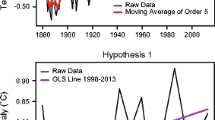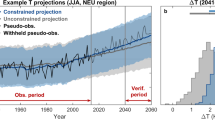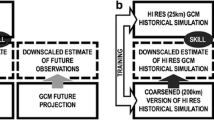Abstract
Explaining the recent slowdown in the rise of global mean surface temperature (the hiatus in warming) has become a major focus of climate research. Efforts to identify the causes of the hiatus that compare simulations from experiments run by climate models raise several statistical issues. Specifically, it is necessary to identify whether an experiment’s inability to simulate the hiatus is unique to this period or reflects a more systematic failure throughout the sample period. Furthermore, efforts to attribute the hiatus to a particular factor by including that mechanism in an experimental treatment must improve the model’s performance in a statistically significant manner at the time of the hiatus. Sample-wide assessments of simulation errors can provide an accurate assessment of whether or not the control experiment uniquely fails at the hiatus, and can identify its causes using experimental treatments. We use this approach to determine if the hiatus constitutes a unique failure in simulated climate models and to re-examine the conclusion that the hiatus is uniquely linked to episodes of La Niña-like cooling (Kosaka and Xie 2013). Using statistical techniques that do not define the hiatus a priori, we find no evidence that the slowdown in temperature increases are uniquely tied to episodes of La Niña-like cooling.


Similar content being viewed by others
Notes
If there is significant feedback, then it is not possible to determine whether the variable explains the hiatus or simply adjusts to the variable of interest.
Non-stationary refers to a non-time-invariant joint distribution.
The divergence of model errors consistent with a deterministic trend appears to be a phenomenon across coupled climate models over the time period. For an abrupt failure of a model during the hiatus, a step-shift change may be more appropriate. Section 3 tests for both trend and step-shift changes.
Multiple breaks in a deterministic trend make it possible to assess whether model failure similar to the hiatus have occurred prior to the hiatus. The presence of breaks is not imposed a-priori, if multiple breaks are detected, this leads to a piece-wise linear representation where later breaks can off-set earlier ones.
This list is non-exhaustive and additional methods are available (see e.g., Perron 2006 for an overview).
Multiple breaks (m) in the intercept alone can be estimated using Bai and Perron (1998) and Bai and Perron (2003). Given that the focus here lies on breaks in the trend, we restrict the analysis to at most one breakpoint in the intercept when using the LS approach. Multiple breaks are covered here using the IS methodology.
False positives are easily controlled in the IS approach. For a sample of T observations, IS for a break in either the trend or intercept implies that T variables are selected over. At the chosen level of significance α one can expect to spuriously retain αT break indicators. When testing for both breaks in the trend and step shifts, we include a full set of step indicators together with our full set of trend functions. To account for the higher number of observations when step shifts and trend changes are allowed, the significance level can be tightened further.
Trimming also limits the maximum number of breaks.
Corresponding code is available on the website of P. Perron: http://people.bu.edu/perron
For the least squares procedure the model with or without breakpoint is determined using the Bayesian Information Criterion (BIC). The trimming factor is set to 0.1, which corresponds to a minimum break length of 6 years.
References
Bai J (1997). Estimation of a change point in multiple regression models. Review of Economics and Statistics, 79(4):551–563
Bai J, Perron P (1998) Estimating and testing linear models with multiple structural changes. Econometrica 66(1):47–78
Bai J, Perron P (2003) Computation and analysis of multiple structural change models. J Appl Econ 18(1):1–22
Castle JL, Doornik JA, Hendry DF, Pretis F (2015) Detecting location shifts during model selection by step-indicator saturation. Econometrics (in press)
Christiano LJ (1992) Searching for a break in GNP. J Bus Econ Stat 10(3):237–250
Delworth T et al (2006) GFDL’s CM2 global coupled climate models. Part I: formulation and simulation characteristics. J Clim 19:643–674
Doornik JA (2009) An object-oriented matrix programming language Ox 6. Timberlake Consultants Press, London
Doornik JA, Hendry DF (2009) Empirical econometric modelling using PcGive: volume I. Timberlake Consultants Press, London
Estrada F, Perron P, Martínez-López B (2013) Statistically derived contribtuions of diverse human influences to twentieth-century temperature changes. Nat Geosci. doi:10.1038/ngeo1999
Gonzalo J, Gadea L (2015) Trend or no trend in distributional characteristics: existence of global warming. Universidad Carlos III de Madrid Working Paper
Haavelmo T (1940) The inadequacy of testing dynamic theory by comparing theoretical solutions and observed cycles. Econometrica 8(4):312–321
Hendry DF, Johansen S (2014) Model discovery and Trygve Haavelmo’s legacy. Econ Theory. doi:10.1017/S0266466614000218
Hendry DF, Richard JF (1982) On the formulation of empirical models in dynamic econometrics. J Econ 20(1):3–33
Johansen S, Nielsen B (2013) Outlier detection in regression using an iterated one-step approximation to the Huber-skip estimator. Econometrics 1(1):53–70
Kaufmann RK, Kauppi H, Mann ML, Stock JH (2011) Reconciling anthropogenic climate change with observed temperature 1998–2008. Proc Natl Acad Sci 108(29):11790–11793. doi:10.1073/pnas.1102467108
Kendall MG (1976) Rank correlation methods. 4th ed. Griffin
Kosaka Y, Xie SP (2013) Recent global-warming hiatus tied to equatorial Pacific surface cooling. Nature 501:403–407
Mann HB (1945) Nonparametric tests against trend. Econometrica: J Econ Soc 13(3):245–259
Meehl GA, Arblaster JM, Fasullo JT, Aixue H, Trenberth KE (2011) Model-based evidence of deep-ocean heat uptake during surface-temperature hiatus periods. Nat Clim Chang 1(7):360–364
Morice CP, Kennedy JJ, Rayner NA, Jones PD (2012) Quantifying uncertainties in global and regional temperature change using an ensemble of observational estimates: the HadCRUT4 data set. J Geophys Res: Atmos. (1984–2012), 117(D8)
Oreskes N, Shrader-Frechette K, Belitz K (1994) Verification, validation, and confirmation of numerical models in the earth sciences. Science 263(5147):641–646
Perron P (2006) Dealing with structural breaks. Palgrave Handb Econ 1:278–352
Perron P, Yabu T (2009) Testing for shifts in trend with an integrated or stationary noise component. J Bus Econ Stat 27:369–396
Perron P, Zhu X (2005) Structural breaks with deterministic and stochastic trends. J Econ 129(1):65–119
Pretis F, Schneider L, Smerdon JE (2014a) Detecting breaks by designed functions applied to volcanic impacts on hemispheric surface temperatures. University of Oxford Department of Economics Discussion Paper
Pretis F, Reade J, Sucarrat G (2014b) gets. An R package for testing for general to specific model selection and indicator saturation
Santer BD, Bonfils C, Painter JF, Zelinka MD, Mears C, Solomon S, Schmidt GA et al (2014) Volcanic contribution to decadal changes in tropospheric temperature. Nat Geosci 7(3):185–189
Santos C, Hendry DF, Johansen S (2008) Automatic selection of indicators in a fully saturated regression. Comput Stat 23(2):317–335
Zivot E, Andrews WKD (1992) Further evidence on the great crash, the oil-price shock, and the unit-root hypothesis. J Bus Econ Stat 20(1):25–44
Acknowledgments
Financial support from the Open Society Foundations and the Oxford Martin School is gratefully acknowledged. We are thankful to David F. Hendry, Max Roser, and Andrew Martinez for helpful comments on an earlier version. We thank Yu Kosaka and Shang-Ping Xie for providing model temperature data.
Author contributions
FP conducted the statistical estimation procedures. MM created the Figures. RK conceived the analysis. All three authors contributed to writing the paper.
Author information
Authors and Affiliations
Corresponding author
Electronic supplementary material
Below is the link to the electronic supplementary material.
ESM 1
(PDF 1.26 MB)
Rights and permissions
About this article
Cite this article
Pretis, F., Mann, M.L. & Kaufmann, R.K. Testing competing models of the temperature hiatus: assessing the effects of conditioning variables and temporal uncertainties through sample-wide break detection. Climatic Change 131, 705–718 (2015). https://doi.org/10.1007/s10584-015-1391-5
Received:
Accepted:
Published:
Issue Date:
DOI: https://doi.org/10.1007/s10584-015-1391-5




